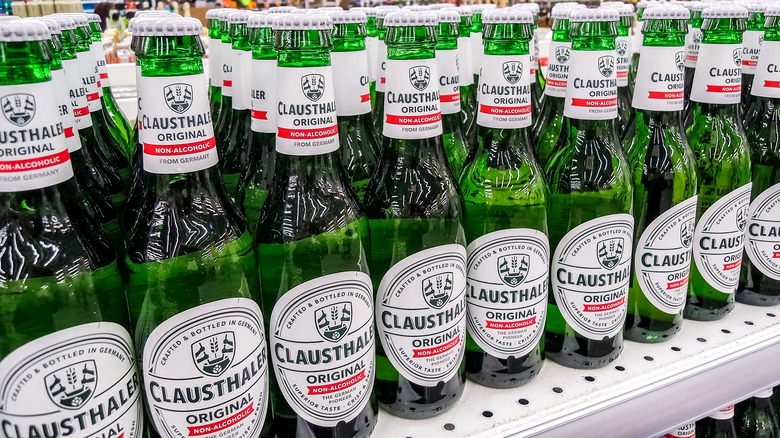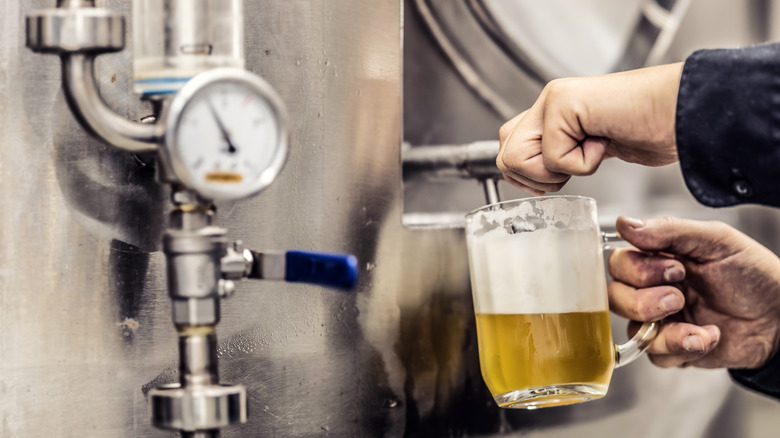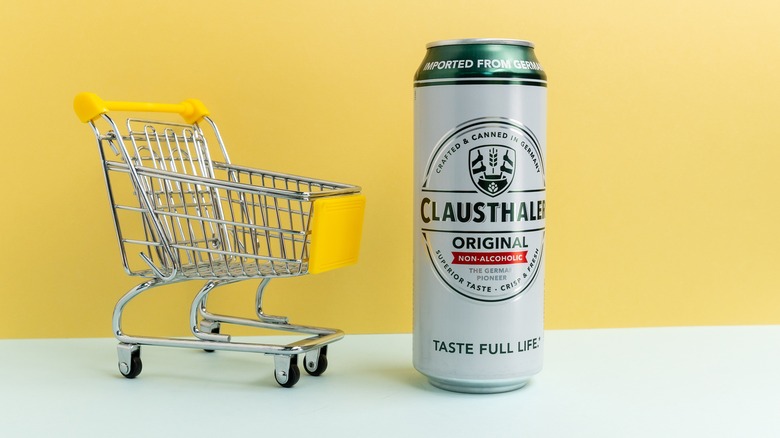The Clever Science Behind The World's Oldest Non-Alcoholic Beer
Recent years have brought an abundance of non-alcoholic beer choices to drinkers looking for great taste without a buzz (As someone who likes having NA options, this writer is especially grateful for Athletic's Run Wild IPA). However, non-alcoholic brews go all the way back to the '70s. Launched in 1979, Clausthaler was the first non-alcoholic beer to go to market. The German manufacturers cracked the NA code with a revolutionary brewing process that kept alcohol from appearing in the beer.
Clausthaler beers are made non-alcoholic through a process known as controlled fermentation. While the beer foundation mixture, known as wort, is typically left to its own devices during yeast-induced fermentation, resulting in an alcoholic brew, controlled fermentation produces a beer with very low alcohol. In Clausthaler's case, this is achieved by making a wort with a very small amount of fermentable sugar in it. Other brewers control fermentation by simply regulating the temperature of the wort, as yeast will only create alcohol at higher temperatures.
Clausthaler's brewmasters were the first to hit upon the process of controlled fermentation, so the company patented its way of doing it. Modern breweries eventually followed Clausthaler's lead, creating a booming market for NA beer.
How controlled fermentation creates non-alcoholic beer
In the 1960s and 1970s, beer manufacturers worldwide struggled to make a beer with little to no alcohol content. Many brewers paid attention to the end of the process and attempted to remove the alcohol from the already-finished drink. Clausthaler created controlled fermentation in 1973, but it would take six more years before its first non-alcoholic beer landed on store shelves.
Clausthaler's method is not substantially different from the typical beer fermentation process. Fermentation for any beer begins with taking the completed wort — which by this point, has already gone through the works of mashing, getting separated from grain, boiling, and cooling — and adding brewing yeast to the mix. The yeast then transforms the sugars found in the wort into alcohol. Yeast needs both oxygen and heat to make alcohol; by using a low-sugar wort, in controlled fermentation, the beer is still fully brewed, but very little alcohol is created.
Today, various methods exist to create NA beers, including simply diluting the beer with water to lower the alcohol content, as well as dealcoholizing, which removed the alcohol from brewed beer by filtration, boiling, or using a vacuum. However, Clausthaler's brewmasters still lay claim to the most unique approach.
How the world's first non-alcoholic beer was sold
Clausthaler recognized that selling non-alcoholic beer could be an uphill struggle. Would drinkers embrace beer without buzz? While there are obvious health and safety benefits to drinking non-alcoholic beer, there were concerns over the stigma of drinking one in public. Ultimately, the company gave up on emphasizing the non-alcoholic aspect to focus on the brew's quality.
When the first Clausthaler beer rolled out, the brewery introduced it as Prinzenbier, which translates to "prince beer" in German. Prinzenbier was marketed to bars and consumers as simply a light beer, itself a new fixture at the time (The first large-scale light beer in America, Miller Lite, debuted in 1972). Over time, Clausthaler emphasized in their advertising that it was a non-alcoholic beer that tasted like a regular beer.
Clausthaler continues to innovate in the market it helped advance. Most beers marketed as non-alcoholic still contain around 0.5% ABV, but the brand introduced a fully 0.0% ABV beer called ISO in 2023.


